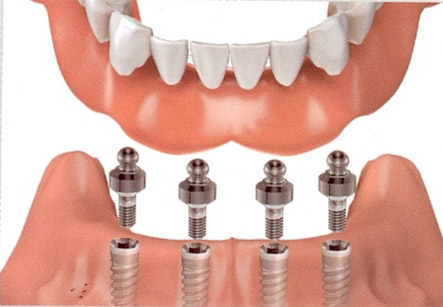Overdentures
Introduction
Loose or painful teeth are usually found in advanced periodontal disease. If many of the teeth have become loose or painful, it may be too late for the dentist to save them. In such a situation, the best way to avoid infection and to restore the health of oral cavity is removing some of the teeth and replacing them with an overdenture.
When seen from outside, an overdenture looks just like a regular denture. When the patient wears a regular denture after removing all the teeth, it causes the bones in the jaw to recede. However, the dentist places an overdenture in a patient who has retained some of the natural teeth. These teeth act as an anchor to keep the denture in place. Therefore, this denture significantly lessens the bone loss and also provides the patient with a more stable denture by leaving some of the roots of the teeth in place.
The procedure
For preparation of the teeth that will support the overdenture, the dentist first removes the portions of the teeth that extend above the gumline. After this, root canal treatment is performed on these teeth to remove any trace of infection. The dentist may also cover them with small metal caps or crowns for added protection.
Iran offers a superior Dental treatments that is world best quality. For patients from the USA, and Europe for example, the savings can be 60% or more

There are several steps in the process of making an overdenture
• The dentist examines the jaw and takes various measurements related to distance between the jaws, their dimensions, apposition and position of remaining teeth.
• From these measurements, a model, plastic or wax pattern of exact dimensions is made depending on protocol. This model serves as a precursor of the final denture. Several adjustments are done regarding size, shape, color and position by trial and error.
• Casting of final denture in the dental laboratory.
• Final adjustments are done if necessary.
Adjusting to the overdenture
• Some temporary problems occur as a normal part of adjusting to the new denture.
• First problems are usually feeling of bulkiness or something alien in the mouth. Increased salivary flow also can occur.
• The tongue may feel crowded, some gagging and difficulty in speech is normal.
• Eating with the denture on may be awkward or difficult in first few days. But with learning and practice, adjustments to the dentures occur. It is like learning a new skill.
• Mouth can be sore or uncomfortable in first week.
• However, after understanding the fact that fitting the dentures improves the health, smile as well as self-confidence, the person eventually adjusts to it.
Care of the overdentures:
1. It is important that the dentures should be kept free from the plaque and tartar, like natural teeth. This helps to prevent permanent staining and bad breath.
2. A denture brush or one of the many commercial cleaning products available can be used at least once a day to thoroughly clean all of the surfaces of the dentures.
3. A soft bristled toothbrush should be used to brush the remaining teeth as well as to clean the tongue, palate, and gums. This removes the plaque and keeps the breath fresh. The cleaning also massages the gums and stimulates circulation, keeping the natural teeth and soft tissues healthy.
4. Tough stains and tartar can be removed by soaking the dentures in white vinegar for several hours. After cleaning, the dentures should always be rinsed in water before placing them in the mouth again.
5. A diluted bleach solution can be used to soak the denture for removing tough stains. This is done if the denture doesn’t have any metal part. Never soak the dentures in a cleaning agent for more than 15 minutes if they have any metal parts.
6. Whenever the dentures are out of the mouth, they should be stored in water.
7. The gums also need a period of rest for remaining healthy, so the dentures should not be worn to bed at night.
8. A dental visit should be paid regularly for examinations to ensure that the dentures fit properly and the mouth is healthy. The dentist should be informed quickly if there are any changes noticed in the bite or fitting.